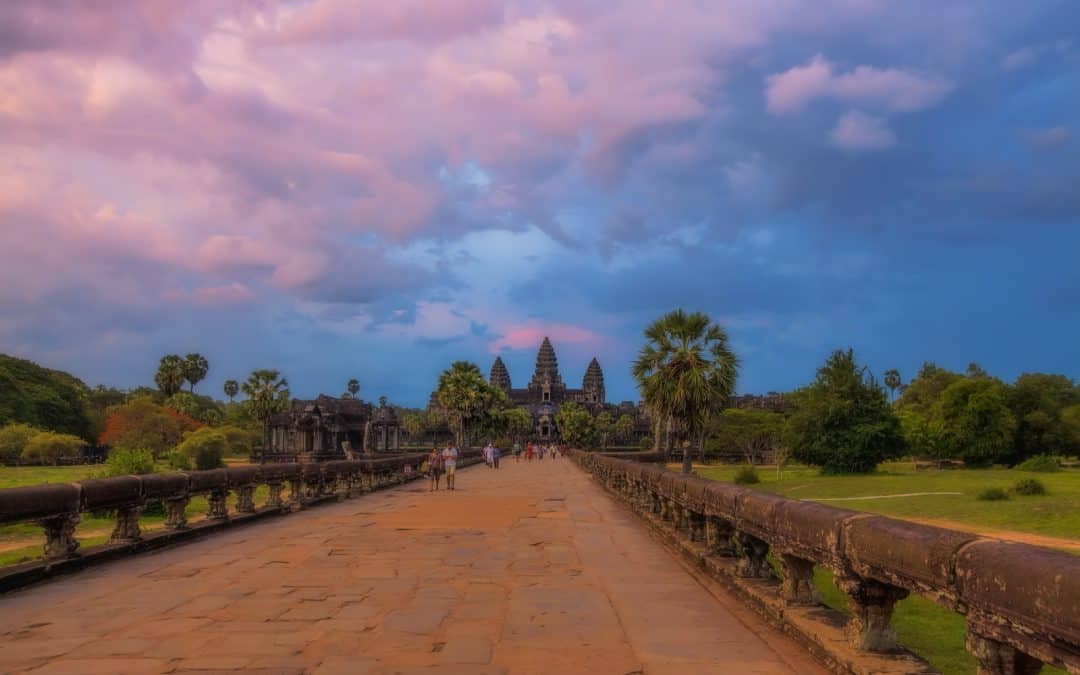Built in the early 12th century, Angkor Wat stands as one of the most impressive architectural wonders from the Khmer Empire’s golden age.
This magnificent temple complex in Cambodia is absolutely breathtaking, with its grand moats, soaring towers, and intricate stone carvings.
If you’re planning a trip to Angkor Wat, get ready for an unforgettable experience as you uncover its rich history, marvel at stunning artwork, and immerse yourself in local culture and traditions.
I’m going to give you insider tips on the must-see temples, famous carvings, and practical advice to help you make the most of your visit to this awe-inspiring UNESCO World Heritage Site.
Whether it’s your first time or you’re returning again, Angkor Wat is sure to dazzle your senses and leave you in awe.
Key Takeaways
- Angkor Wat is a Hindu temple complex built during the early 12th century.
- Top temples to visit include Bayon, Ta Prohm, Angkor Thom, and Banteay Srei.
- The carvings and artwork depict scenes from Hindu mythology and offer a glimpse into Khmer civilization.
- Angkor Wat reflects Cambodia’s cultural practices and traditions, including Buddhist worship and traditional performances.
History and Origins
If you’re interested in the history and origins of Angkor Wat, one key aspect to understand is its construction during the early 12th century.
This period holds great historical significance as it marks the rise of the Khmer Empire under King Suryavarman II.
Angkor Wat, located in present-day Cambodia, was built as a Hindu temple dedicated to the deity Vishnu. It stands as one of the most remarkable architectural marvels of its time.
The construction of Angkor Wat showcases the Khmer Empire’s exceptional engineering skills and artistic achievements.
The temple complex spans over 400 acres and is surrounded by a vast moat, symbolizing the cosmic ocean.
Its central tower, reaching a height of 213 feet, represents Mount Meru, the mythical home of the gods.
Intricate carvings depicting scenes from Hindu mythology adorn the walls, demonstrating the mastery of Khmer artisans.
Angkor Wat’s historical significance extends beyond its magnificent architecture.
It served as the spiritual and political center of the Khmer Empire, symbolizing the empire’s prosperity and divine connection.
The temple complex also played a crucial role in the spread of Hinduism and later Buddhism in Southeast Asia.
Understanding the history and origins of Angkor Wat provides a deeper appreciation for its cultural and historical value.
Visiting this architectural wonder allows you to step back in time and witness the legacy of the Khmer Empire firsthand.
Top Temples to Visit
When planning your visit to Angkor Wat, I recommend that you check out the top temples in the area.
These temples not only showcase the impressive temple architecture of the Khmer Empire but also provide an opportunity to witness religious ceremonies that have been practiced for centuries.
One of the must-visit temples is Bayon, known for its iconic stone faces carved into the towers.
As you wander through the temple, you’ll be captivated by the intricate details and the sense of spirituality that permeates the air.
Another temple worth visiting is Ta Prohm, famous for its intertwining tree roots that have grown over the temple’s stone structures.
This unique blend of nature and architecture creates a mystical atmosphere that’s truly enchanting.
For a glimpse into the grandeur of the Angkor Empire, head to Angkor Thom.
This sprawling temple complex is home to the renowned Terrace of the Elephants, where royal ceremonies and processions once took place.
You also don’t miss Banteay Srei, a smaller temple known for its intricate and delicate carvings. This temple is a testament to the skill and craftsmanship of the Khmer artisans.
Visiting these top temples won’t only give you a deeper appreciation for the temple architecture of Angkor Wat but also allow you to witness the splendor of religious ceremonies that are still practiced to this day.
Must-See Carvings and Artwork
Explore the intricate carvings and artwork that adorn the temples of Angkor Wat, immersing yourself in the rich history and craftsmanship of the Khmer Empire.
As you venture through this magnificent UNESCO World Heritage Site, you’ll encounter famous sculptures and architectural wonders that will leave you in awe.
One of the most renowned carvings in Angkor Wat is the Churning of the Ocean of Milk.
This bas-relief depicts a Hindu mythological scene, where gods and demons churn the cosmic ocean to extract the elixir of immortality.
The level of detail and precision in this carving is truly remarkable, with every character and element intricately portrayed.
Another must-see carving can be found at the Terrace of the Leper King.
This sculpture, known as the Leper King statue, showcases a skeletal figure believed to be a representation of Yama, the god of death.
The statue is adorned with intricate patterns and carvings, showcasing the exceptional craftsmanship of the Khmer artisans.
As you explore the temples, take a moment to appreciate the delicate carvings that adorn the walls and pillars.
These intricate designs depict various scenes from Hindu mythology, religious rituals, and daily life during the Khmer Empire.
From celestial dancers and mythical creatures to battle scenes and agricultural activities, these carvings offer a glimpse into the vibrant history and culture of the ancient Khmer civilization.
The carvings and artwork of Angkor Wat aren’t just decorative elements; they’re windows into a bygone era, telling stories of a glorious past.
So, as you marvel at the famous sculptures and architectural wonders, remember to take a moment to appreciate the skill, talent, and dedication of the artisans who created these masterpieces.
Cultural Significance and Traditions
As you continue your exploration of Angkor Wat’s must-see carvings and artwork, I recommending taking a deeper look into the cultural significance and traditions that have shaped this magnificent UNESCO World Heritage Site.
Angkor Wat isn’t just a stunning architectural marvel, but it also holds immense cultural importance.
The site is deeply rooted in the rich history of Cambodia and reflects the cultural practices and local customs of its people.
One of the cultural practices that can be observed at Angkor Wat is the act of Buddhist worship.
Many locals and visitors come to the temple complex to pay their respects and engage in religious rituals.
You may witness people lighting incense, making offerings, and meditating in the serene surroundings.
These practices not only reflect the spiritual beliefs of the Cambodian people but also contribute to the peaceful and tranquil atmosphere of Angkor Wat.
Another aspect of cultural significance is the preservation of traditional Khmer dance and music.
Performances are held regularly, showcasing the graceful movements and melodious tunes that have been passed down through generations.
These performances not only entertain but also serve as a way to preserve and honor Cambodia’s cultural heritage.
In addition to these cultural practices, Angkor Wat also offers a glimpse into local customs.
From observing traditional clothing and traditional ceremonies to tasting local cuisine, you’ll have the opportunity to immerse yourself in the vibrant local culture.
Practical Tips and Advice
When it comes to tourist accommodations, you have a range of options to choose from.
There are luxury hotels, budget guesthouses, and even homestays where you can experience the local way of life.
It’s advisable to book your accommodation in advance, especially during peak tourist seasons, to ensure availability.
Now let’s talk about the local cuisine.
Cambodian food is diverse and delicious, with influences from Thai, Vietnamese, and Chinese cuisines.
Don’t miss the opportunity to try some of the traditional dishes such as Amok, a fragrant fish curry steamed in banana leaves, and Lok Lak, a stir-fried beef dish served with a tangy sauce.
Street food is also popular in Cambodia, and you can find vendors selling everything from noodles to grilled meats.
However, it’s important to be cautious and choose vendors that have good hygiene practices to avoid any stomach issues.
Conclusion
Angkor Wat is truly an unforgettable experience, allowing you to step back in time and immerse yourself in the rich history and culture of the Khmer Empire.
As you wander through the stone hallways and marvel at the extraordinary craftsmanship, you’ll gain a deeper appreciation for the ingenuity and artistry of the ancient Khmer people.
With this guide’s practical tips and must-see recommendations in hand, you’re ready to plan your own adventure exploring the grandeur and mysteries of Angkor Wat.



